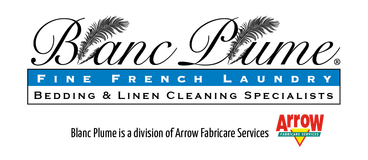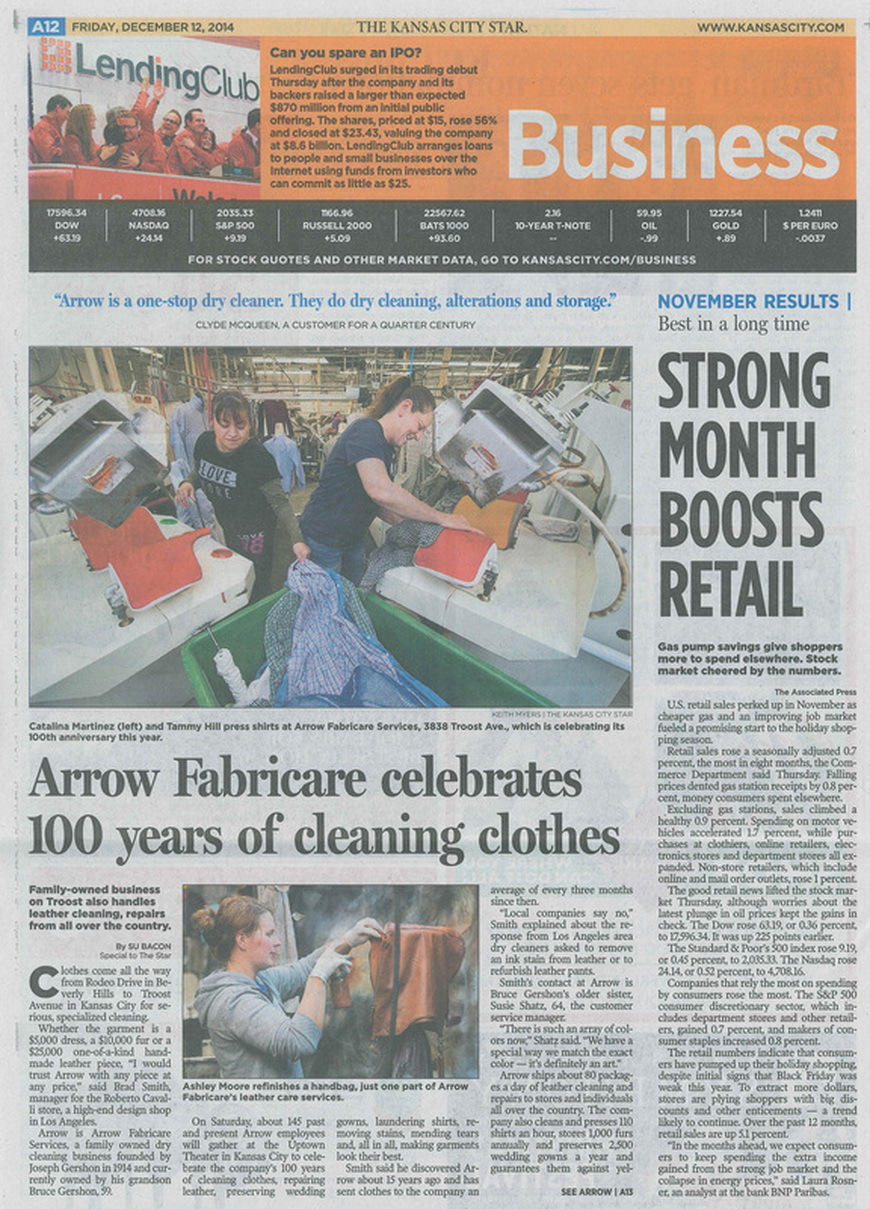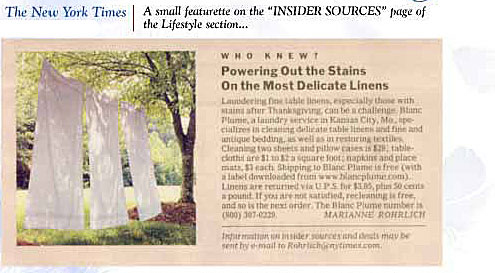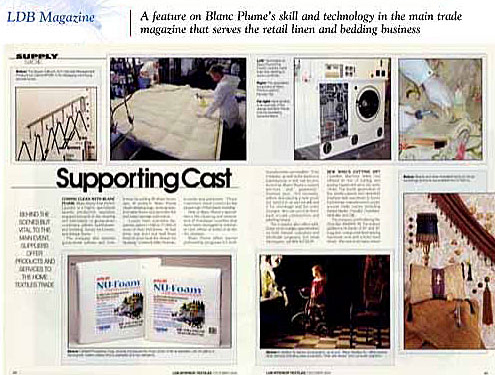Nationwide Service
December 11th, 2014 - Kansas City Star
Family Business Thrives
| |||||||
KC Business Magazine Top Companies of Kansas City 2014 - Arrow received "The Phoenix" Award
| |||||||
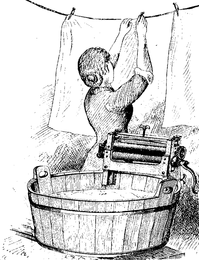
Blanc Plume's story attracts media coverage Fine French Laundry is a term in current usage in the dry cleaning and textile manufacturing industries that quickly describes the processing of important garments, bedding and linens in very personal ways.
The French Laundry methods include carefully washing in the most safe and preservative solutions along with delicate handling. It includes rinsing with multiple cycles (as many as 7-10 times) and it includes hand work ironing.
In short, French Laundry describes the specialized care and prevention just as wardrobes, linens and bedding were handled during the European ages of aristocracy and the impeccable work that was required to please their taste for perfection.
The French Laundry methods include carefully washing in the most safe and preservative solutions along with delicate handling. It includes rinsing with multiple cycles (as many as 7-10 times) and it includes hand work ironing.
In short, French Laundry describes the specialized care and prevention just as wardrobes, linens and bedding were handled during the European ages of aristocracy and the impeccable work that was required to please their taste for perfection.

CURRENTS: WHO KNEW?;
Powering Out the Stains On the Most Delicate Linens
By MARIANNE ROHRLICH Published: November 15, 2001
Laundering fine table linens, especially those with stains after Thanksgiving, can be a challenge. Blanc Plume, a laundry service in Kansas City, Mo., specializes in cleaning delicate table linens and fine and antique bedding, as well as in restoring textiles. Cleaning two sheets and pillow cases is $29; tablecloths are $1 to $2 a square foot; napkins and place mats, $3 each. Shipping to Blanc Plume is free (with a label downloaded from www.blancplume.com). Linens are returned via U.P.S. for $3.95*, plus 50 cents a pound. If you are not satisfied, re cleaning is free, and so is the next order. The Blanc Plume number is (800) 307-0229. MARIANNE ROHRLICH
Information on insider sources and deals may be sent by e-mail to [email protected].
Powering Out the Stains On the Most Delicate Linens
By MARIANNE ROHRLICH Published: November 15, 2001
Laundering fine table linens, especially those with stains after Thanksgiving, can be a challenge. Blanc Plume, a laundry service in Kansas City, Mo., specializes in cleaning delicate table linens and fine and antique bedding, as well as in restoring textiles. Cleaning two sheets and pillow cases is $29; tablecloths are $1 to $2 a square foot; napkins and place mats, $3 each. Shipping to Blanc Plume is free (with a label downloaded from www.blancplume.com). Linens are returned via U.P.S. for $3.95*, plus 50 cents a pound. If you are not satisfied, re cleaning is free, and so is the next order. The Blanc Plume number is (800) 307-0229. MARIANNE ROHRLICH
Information on insider sources and deals may be sent by e-mail to [email protected].

A featured article from LDB Interior textile December 2005
By Julie McGovern
The Best of Both Worlds
Blanc Plume Fine French Laundry treats luxury linens with a combination of old-world technique and new-world technology. The company was founded as a laundry service for retail linen stores, to ensure the proper care of bedding and delicate down products. The cleaning process incorporates European methods like blocking, which air-dries linens without shrinkage, with computerized equipment designed specifically for home textiles. Blanc Plume prides itself on its ability to treat and remove stains on the most delicate items, such as goose-down featherbeds, wool mattress pads, christening gowns, lace table linens, and silk products.
In addition to protecting customers' investment in fine linens, Blanc Plume affords retailers the opportunity to build consumer loyalty. Key benefits for participating retailers include increased foot traffic; additional profits through a referral bonus program; a solution to the "How do I care for this?" issue in purchasing luxury linens; and the option to clean display merchandise as well as personal or employee goods at wholesale cost. The growing company has recently come under the ownership and management of Arrow Fabricare Services, the largest specialty dry cleaner in America.
With Blanc Plume's Fine French Laundry service, luxury linen retailers give consumers another reason to visit. For more information call 800-307-0229 or visit www.BlancPlume.com.
By Julie McGovern
The Best of Both Worlds
Blanc Plume Fine French Laundry treats luxury linens with a combination of old-world technique and new-world technology. The company was founded as a laundry service for retail linen stores, to ensure the proper care of bedding and delicate down products. The cleaning process incorporates European methods like blocking, which air-dries linens without shrinkage, with computerized equipment designed specifically for home textiles. Blanc Plume prides itself on its ability to treat and remove stains on the most delicate items, such as goose-down featherbeds, wool mattress pads, christening gowns, lace table linens, and silk products.
In addition to protecting customers' investment in fine linens, Blanc Plume affords retailers the opportunity to build consumer loyalty. Key benefits for participating retailers include increased foot traffic; additional profits through a referral bonus program; a solution to the "How do I care for this?" issue in purchasing luxury linens; and the option to clean display merchandise as well as personal or employee goods at wholesale cost. The growing company has recently come under the ownership and management of Arrow Fabricare Services, the largest specialty dry cleaner in America.
With Blanc Plume's Fine French Laundry service, luxury linen retailers give consumers another reason to visit. For more information call 800-307-0229 or visit www.BlancPlume.com.
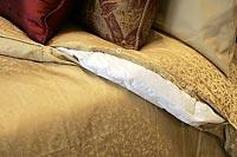 DAVID PULLIAM / KANSAS CITY STAR
DAVID PULLIAM / KANSAS CITY STAR
Here are some comforter thoughts By Stacy Downs
The Kansas City Star
A down comforter peeks out from a duvet cover. Colorful comforters with the filling sewn inside typically cost less than comforters that need duvet covers. However, decorative comforters don't provide the warmth or last as long as those with duvet covers.
Glossary
Baffling: Vertical walls of fabric are sewn inside the ticking, then filled with down. Baffling, as opposed to quilting (simply sewing together the top and bottom layers of ticking), allow down comforters to assume their fullest loft. Also referred to as "baffle boxes" and "baffle construction."
Coverlet: A thin decorative comforter.
Down blanket: A thin down comforter for summer use or for sleepers who enjoy cool temperatures. They come in colors, but cover them with a sheet to maintain them.
Duvet cover: A sheet that buttons over a comforter for protection and decoration. The best covers are thin, like sheets. Those with upholstery-thick fabric flatten comforters.
Primaloft: The name for synthetic microfibers that mimic the warmth and feeling of down. The water-repellent material was developed for the U.S. military for clothes and sleeping bags.
Resources
Garnet Hill: www.garnethill.com or 800-870-3513
Cuddledown: www.cuddledown.com or 800-323-6793
Scandia Down: www.scandiadown.com or 800-237-5337
Comforter care
Maintenance
Use duvet covers to keep high-quality comforters clean.
Shake out down comforters daily to restore their loft.
Cleaning
Cotton-filled comforters should be dry-cleaned seasonally. Clean spots with a mild detergent and warm water.
Down comforters may be professionally cleaned every other year.
Polyester-filled or synthetic down comforters protected by duvet covers should be laundered professionally or at home annually. Wash cold on the gentle cycle. Dry on low heat. Those with filling sewn inside a decorative shell should be laundered monthly according to label instructions.
Silk-filled comforters should be dry-cleaned annually.
Storage
When they're not in use, all comforters should be kept in a breathable fabric bag or wrapped and tied inside a sheet.
Store a wrapped comforter in a cool, dry area.
Restoration
More down can be sewn into down comforters. Prices start at $7 per ounce*.
A damaged outer shell of a comforter can be replaced for about $150.
Sources: Connie Mosier, Blanc Plume Fine French Laundry; Ursula Terrasi, Scandia Down; Janet Partridge, Garnet Hill
Choosing a comforter can be a chore.
So many options are out there and most are expensive, even at discount stores. People also use comforters differently. Many buy a purely decorative comforter, using it as a bedspread and layering blankets and sheets underneath. Others buy a down comforter and a duvet cover, so warm that no flat sheet or blanket is required.
A decorative comforter for an adult, usually filled with polyester, starts at more than $150 for a queen. A good-quality down or silk comforter costs at least $300. Plan on spending at least $100 more for a duvet cover.
Decorative comforters are best for kids' rooms because they can be thrown into the washing machine a few times a month. Although they're less expensive, they wear faster. Their colors fade, and they eventually show dirt because their bulk makes them difficult to launder in the average machine.
But a down or silk comforter, with a duvet cover and proper maintenance, can last more than 20 years. Like quilts, they can become heirlooms. Before shopping, consider these aspects of comforters:
Sleeping preferences: If you want to be toasty warm in winter, nothing beats natural down comforters. Down refers to the insulating fluff balls that grow on the breasts of geese and ducks, not the two-dimensional quilled feathers that keep birds dry. People appreciate not only the warmth of down comforters but also their cloudlike lightness.
"Down comforters just float on top of you," says Lisa Payne , co-owner of Annabelles, an Overland Park, Kan., store that carries a variety of comforter styles. "Other types aren't as warm and are heavy enough that they hurt your feet."
Down comforters vary by fill power, the amount of space in cubic inches an ounce of down fills. The higher the fill power, the warmer the comforter. Good-quality down comforters start at more than 550 fill power, according to Ursula Terrasi, owner of Scandia Down in Kansas City. "I have an all-season one so I can sleep in down year-round," she says.
Couples who prefer different sleeping temperatures can choose down comforters with a lower fill power on one side and a higher fill power on the other. But the customized option can add on hundreds of dollars and can result in a lopsided look, Payne says.
Polar-bear sleepers — those who like to sleep with the windows cracked in the winter — prefer silk-filled comforters. Silk is not as puffy as down, and it feels heavier.
"I'm a cool sleeper; so I like silk best," says Janet Partridge, a spokeswoman for Garnet Hill catalog. "Silk comforters have finger fibers that tighten and contour to the body."
Allergies: Some people forgo down, fearing it will aggravate allergies. But Payne and Terrasi suggest allergy sufferers try down before getting an alternative.
"It's the dust particles and dander on improperly cleaned down that give people problems," Terrasi says. "People should ask about the down cleaning process before buying a comforter."
Allergy sufferers often opt for synthetic down such as Primaloft, or comforters filled with natural fibers such as silk.
Quality: Examine how far apart the stitches are from one another. Tight, close stitches will keep a comforter intact longer.
Feel the ticking, the outer shell of the comforter. Even through a duvet cover, each type of material has a different texture and weight. Most people prefer an Egyptian cotton ticking because it's soft and smooth. Silk or polyester ticking can feel luxurious to some, slippery to others.
Fine bedding stores often encourage customers to lie on a bed under different types of ticking and levels of fill power so they can choose what they like best.
Copyright © 2006 The Seattle Times Company
The Kansas City Star
A down comforter peeks out from a duvet cover. Colorful comforters with the filling sewn inside typically cost less than comforters that need duvet covers. However, decorative comforters don't provide the warmth or last as long as those with duvet covers.
Glossary
Baffling: Vertical walls of fabric are sewn inside the ticking, then filled with down. Baffling, as opposed to quilting (simply sewing together the top and bottom layers of ticking), allow down comforters to assume their fullest loft. Also referred to as "baffle boxes" and "baffle construction."
Coverlet: A thin decorative comforter.
Down blanket: A thin down comforter for summer use or for sleepers who enjoy cool temperatures. They come in colors, but cover them with a sheet to maintain them.
Duvet cover: A sheet that buttons over a comforter for protection and decoration. The best covers are thin, like sheets. Those with upholstery-thick fabric flatten comforters.
Primaloft: The name for synthetic microfibers that mimic the warmth and feeling of down. The water-repellent material was developed for the U.S. military for clothes and sleeping bags.
Resources
Garnet Hill: www.garnethill.com or 800-870-3513
Cuddledown: www.cuddledown.com or 800-323-6793
Scandia Down: www.scandiadown.com or 800-237-5337
Comforter care
Maintenance
Use duvet covers to keep high-quality comforters clean.
Shake out down comforters daily to restore their loft.
Cleaning
Cotton-filled comforters should be dry-cleaned seasonally. Clean spots with a mild detergent and warm water.
Down comforters may be professionally cleaned every other year.
Polyester-filled or synthetic down comforters protected by duvet covers should be laundered professionally or at home annually. Wash cold on the gentle cycle. Dry on low heat. Those with filling sewn inside a decorative shell should be laundered monthly according to label instructions.
Silk-filled comforters should be dry-cleaned annually.
Storage
When they're not in use, all comforters should be kept in a breathable fabric bag or wrapped and tied inside a sheet.
Store a wrapped comforter in a cool, dry area.
Restoration
More down can be sewn into down comforters. Prices start at $7 per ounce*.
A damaged outer shell of a comforter can be replaced for about $150.
Sources: Connie Mosier, Blanc Plume Fine French Laundry; Ursula Terrasi, Scandia Down; Janet Partridge, Garnet Hill
Choosing a comforter can be a chore.
So many options are out there and most are expensive, even at discount stores. People also use comforters differently. Many buy a purely decorative comforter, using it as a bedspread and layering blankets and sheets underneath. Others buy a down comforter and a duvet cover, so warm that no flat sheet or blanket is required.
A decorative comforter for an adult, usually filled with polyester, starts at more than $150 for a queen. A good-quality down or silk comforter costs at least $300. Plan on spending at least $100 more for a duvet cover.
Decorative comforters are best for kids' rooms because they can be thrown into the washing machine a few times a month. Although they're less expensive, they wear faster. Their colors fade, and they eventually show dirt because their bulk makes them difficult to launder in the average machine.
But a down or silk comforter, with a duvet cover and proper maintenance, can last more than 20 years. Like quilts, they can become heirlooms. Before shopping, consider these aspects of comforters:
Sleeping preferences: If you want to be toasty warm in winter, nothing beats natural down comforters. Down refers to the insulating fluff balls that grow on the breasts of geese and ducks, not the two-dimensional quilled feathers that keep birds dry. People appreciate not only the warmth of down comforters but also their cloudlike lightness.
"Down comforters just float on top of you," says Lisa Payne , co-owner of Annabelles, an Overland Park, Kan., store that carries a variety of comforter styles. "Other types aren't as warm and are heavy enough that they hurt your feet."
Down comforters vary by fill power, the amount of space in cubic inches an ounce of down fills. The higher the fill power, the warmer the comforter. Good-quality down comforters start at more than 550 fill power, according to Ursula Terrasi, owner of Scandia Down in Kansas City. "I have an all-season one so I can sleep in down year-round," she says.
Couples who prefer different sleeping temperatures can choose down comforters with a lower fill power on one side and a higher fill power on the other. But the customized option can add on hundreds of dollars and can result in a lopsided look, Payne says.
Polar-bear sleepers — those who like to sleep with the windows cracked in the winter — prefer silk-filled comforters. Silk is not as puffy as down, and it feels heavier.
"I'm a cool sleeper; so I like silk best," says Janet Partridge, a spokeswoman for Garnet Hill catalog. "Silk comforters have finger fibers that tighten and contour to the body."
Allergies: Some people forgo down, fearing it will aggravate allergies. But Payne and Terrasi suggest allergy sufferers try down before getting an alternative.
"It's the dust particles and dander on improperly cleaned down that give people problems," Terrasi says. "People should ask about the down cleaning process before buying a comforter."
Allergy sufferers often opt for synthetic down such as Primaloft, or comforters filled with natural fibers such as silk.
Quality: Examine how far apart the stitches are from one another. Tight, close stitches will keep a comforter intact longer.
Feel the ticking, the outer shell of the comforter. Even through a duvet cover, each type of material has a different texture and weight. Most people prefer an Egyptian cotton ticking because it's soft and smooth. Silk or polyester ticking can feel luxurious to some, slippery to others.
Fine bedding stores often encourage customers to lie on a bed under different types of ticking and levels of fill power so they can choose what they like best.
Copyright © 2006 The Seattle Times Company
*Pricing has been updated since the publication was printed. Please refer to Blanc Plume's current pricing by going to the pricing tab listed above.
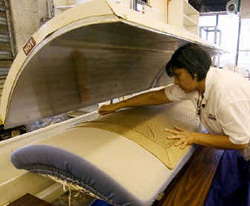
Awash in luxury
At Blanc Plume in KC, sheets and table cloths get special, hands-on treatment.
By Stacy Downs
The Kansas City Star
Photos by John Mutrux | The Kansas City Star
Blanc Plume employee Susana Martinez uses a 7-foot press to smooth a damp bedsheet in one step. Some laundry services instead use a mangle, a heated-roller machine that smoothes fabric. A mangle can leave slight creases around the edges.
The large "stretching frame" assures that coverlets are returned to the customer at their original size and do not shrink. Shrinkage is a large problems when hi-end bedding is processed by a dry cleaner who does not specialize in the work.
There are only a handful of French laundries in the United States, and Kansas City can boast having one of them - Blanc Plume in North Kansas City.
Richard Triggs of Kansas City takes his Egyptian cotton sheets to Blanc Plume ("white feather") to be laundered a few times a month. "It's kind of a treat," he said. "It feels like you're sleeping on brand-new sheets again."
French laundries specialize in luxury linens such as bedding made of Egyptian cotton, merino wool, pure linen, cashmere or silk.
They also clean intricately decorated pieces such as pillows beaded with crystals. These laundries are where you'd take heirloom pieces (Grandma's embroidered tablecloth) but not necessarily bedding from a discount retailer.
At a French laundry, stains are individually pretreated with a mild solution before being washed. Linens are pressed damp to ensure a crisp finish.
Special attention is paid to details. For example, tassels and fringe are bundled or braided before laundering to prevent balling or knotting, says Connie Mosier, general manager of Blanc Plume, a division of Arrow Fabricare. After laundering, the fringe is finger combed.
Luxury linen companies such as Anichini, DeWoolfson, Duxiana, Peacock Alley and Yves Delorme recommend that their products be laundered at Blanc Plume. "They're the best," said Alan Jesseman, creative director for Anichini, a Vermont company that uses handcrafted fabrics from Lithuania and Italy to make bedding for boutiques and hotels.
Blanc Plume employees have expertise that goes beyond a traditional dry cleaner or laundry service, Jesseman said.
Anichini customers receive a packet of information about Blanc Plume and a shipping label. Blanc Plume receives linens for laundering from across the country.
Linen store owners also recommend Blanc Plume for restoration. Ursula Terrasi, owner of Scandia Down on the Country Club Plaza, said a customer once brought in a matelasse coverlet that had been machine laundered at home. It shrunk, was wrinkled and no longer fit the bed. "They took it to Blanc Plume and when it was returned, it was like nothing had happened," Terrasi said.
Matelassé is a triple-woven cotton jacquard fabric with raised patterning that requires professional laundering. It naturally shrinks up to 10 percent when it's washed. Blanc Plume measures the coverlet and uses a blocking process to retain the original size.
The blocking process also is used to stretch lace tablecloths and bedskirts that have high-quality skirting fabric but inexpensive decking material that makes them hang improperly.
Blanc Plume also specializes in down comforter and pillow restoration. Down products should be professionally cleaned every other year to help redistribute the down. The company can add additional down and replace the ticking, or outer shell, if needed. The "down room" is enclosed with a screened door so the lightweight fluffy stuff doesn't float throughout the facility at 1333 Washington Blvd..
Patsy Thomas of Kansas City takes her down products, needlepoint chair cushions and tablecloths to Blanc Plume. She likes how comforters come back wrapped in heavy plastic zippered bags. Tablecloths are returned rolled or folded precisely with acid-free tissue paper.
"When I take my tablecloths out for the next holiday, they look done up to perfection," Thomas said. "It (Blanc Plume) is a great secret source to have in town."
At Blanc Plume in KC, sheets and table cloths get special, hands-on treatment.
By Stacy Downs
The Kansas City Star
Photos by John Mutrux | The Kansas City Star
Blanc Plume employee Susana Martinez uses a 7-foot press to smooth a damp bedsheet in one step. Some laundry services instead use a mangle, a heated-roller machine that smoothes fabric. A mangle can leave slight creases around the edges.
The large "stretching frame" assures that coverlets are returned to the customer at their original size and do not shrink. Shrinkage is a large problems when hi-end bedding is processed by a dry cleaner who does not specialize in the work.
There are only a handful of French laundries in the United States, and Kansas City can boast having one of them - Blanc Plume in North Kansas City.
Richard Triggs of Kansas City takes his Egyptian cotton sheets to Blanc Plume ("white feather") to be laundered a few times a month. "It's kind of a treat," he said. "It feels like you're sleeping on brand-new sheets again."
French laundries specialize in luxury linens such as bedding made of Egyptian cotton, merino wool, pure linen, cashmere or silk.
They also clean intricately decorated pieces such as pillows beaded with crystals. These laundries are where you'd take heirloom pieces (Grandma's embroidered tablecloth) but not necessarily bedding from a discount retailer.
At a French laundry, stains are individually pretreated with a mild solution before being washed. Linens are pressed damp to ensure a crisp finish.
Special attention is paid to details. For example, tassels and fringe are bundled or braided before laundering to prevent balling or knotting, says Connie Mosier, general manager of Blanc Plume, a division of Arrow Fabricare. After laundering, the fringe is finger combed.
Luxury linen companies such as Anichini, DeWoolfson, Duxiana, Peacock Alley and Yves Delorme recommend that their products be laundered at Blanc Plume. "They're the best," said Alan Jesseman, creative director for Anichini, a Vermont company that uses handcrafted fabrics from Lithuania and Italy to make bedding for boutiques and hotels.
Blanc Plume employees have expertise that goes beyond a traditional dry cleaner or laundry service, Jesseman said.
Anichini customers receive a packet of information about Blanc Plume and a shipping label. Blanc Plume receives linens for laundering from across the country.
Linen store owners also recommend Blanc Plume for restoration. Ursula Terrasi, owner of Scandia Down on the Country Club Plaza, said a customer once brought in a matelasse coverlet that had been machine laundered at home. It shrunk, was wrinkled and no longer fit the bed. "They took it to Blanc Plume and when it was returned, it was like nothing had happened," Terrasi said.
Matelassé is a triple-woven cotton jacquard fabric with raised patterning that requires professional laundering. It naturally shrinks up to 10 percent when it's washed. Blanc Plume measures the coverlet and uses a blocking process to retain the original size.
The blocking process also is used to stretch lace tablecloths and bedskirts that have high-quality skirting fabric but inexpensive decking material that makes them hang improperly.
Blanc Plume also specializes in down comforter and pillow restoration. Down products should be professionally cleaned every other year to help redistribute the down. The company can add additional down and replace the ticking, or outer shell, if needed. The "down room" is enclosed with a screened door so the lightweight fluffy stuff doesn't float throughout the facility at 1333 Washington Blvd..
Patsy Thomas of Kansas City takes her down products, needlepoint chair cushions and tablecloths to Blanc Plume. She likes how comforters come back wrapped in heavy plastic zippered bags. Tablecloths are returned rolled or folded precisely with acid-free tissue paper.
"When I take my tablecloths out for the next holiday, they look done up to perfection," Thomas said. "It (Blanc Plume) is a great secret source to have in town."
